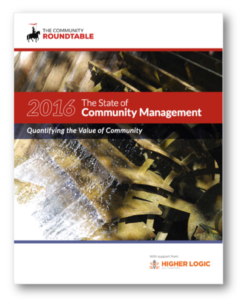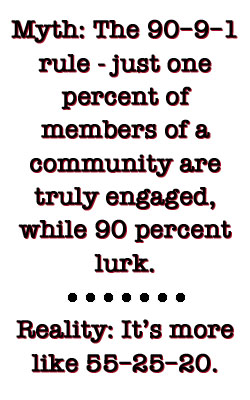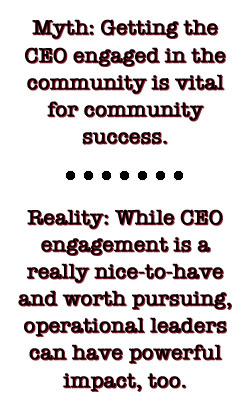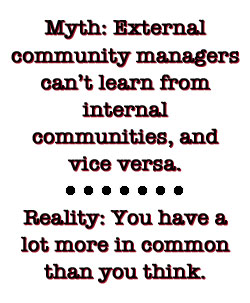By Ted McEnroe, Director of Research and Training, The Community Roundtable

We talk a lot about 2016 being the seventh edition of The State of Community Management- and it is worth noting. The field of community management has changed remarkably in those seven years – while communities have been around forever, the way we look at them strategically has undergone a radical and beneficial transformation.
And our research has changed as well – from an examination of best practices collected anecdotally, to a longitudinal study of communities, to a more thorough examination of the strategies, operations and tactics that separate successful communities from others – and take into account the time, resources and human effort to make communities successful.
Along the way, we continue to bust myths and assumptions about community that have been holding us back. That trend continues in 2016 – as you’ll see when this year’s full report comes out next month.
Myth: The 90–9–1 rule – just one percent of members of a community are truly engaged,while 90 percent lurk.
Reality: More like 55–25–20.
Communities are complex organisms, and really, no one “rule” will define engagement percentages for every community. But consistently over the past three years, our research has found that engagement levels in communities are consistently higher than the old assumption.
That’s not to say there aren’t big, external (usually) communities that aren’t 90–9–1. And whether you count inactive but registered members, how you set up the community permissions and other items can have an effect on your numbers. But when you normalize for members who log into a community during a given month – you’re more likely to find that a sizable minority are posting, commenting, creating, liking, sharing and collaborating.
Members are not sitting, watching and listening. They’re getting up and dancing.
 Myth: Getting the CEO engaged in the community is vital for community success.
Myth: Getting the CEO engaged in the community is vital for community success.
Reality: While CEO engagement is a really nice-to-have and worth pursuing, operational leaders can have powerful impact, too.
Look, there’s no question that executive engagement is a critical element of community success. But we’ve become much more sophisticated in our understanding of executives and how they connect with community. Turns out, they’re kind of like everyone else. About 40–45% of C-level executives engage in communities in some form. (Look familiar? That’s about the same percentage of “active” members in a community as a whole.) A much smaller percentage make the full transition from outsider to socially-engaged executive – but we’ve held a myth that getting the C-level there was vital for community success.
Instead, we’re seeing something more subtle. Our best-in-class communities do have more engaged C-suites than their peers. But where they really outshine the rest is at lower levels. Their subject matter experts and directors are much more likely to be engaged.
The lesson? Work on the C-suite, and at a minimum, make sure they understand the power of community. But don’t expect/count on miracles, and cast a wide net for managerial engagement.
 Myth: External community managers can’t learn from internal communities,and vice versa.
Myth: External community managers can’t learn from internal communities,and vice versa.
Reality: You have a lot more in common than you think.
Every community is different – but the data shows that communities with different use cases face similar challenges, and use the same community management strategies, operations and tactics to achieve success.
In the engagement and leadership pieces above – the data for internal and external communities (if you normalize for the differences in inactives) are basically the same. The best communities in internal and external use cases are about equally likely to have an approved strategy, a dedicated budget, a resourced roadmap, full-time community management, and so on.
That’s not to say that they are identical. In fact, one of the reasons I am so excited that we received such strong participation in the 2016 survey is that we will be able to, for the first time, explore the differences between communities within more specific subgroups and see the subtle differences in practice that make each case different.
But the data has shown, and will do so again this year, that your peers aren’t just the other community managers in organizations that look just like yours. And that broadens the opportunity to learn.
Are you a member of TheCR Network? Download the research inside the Network here.
